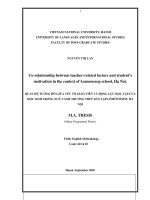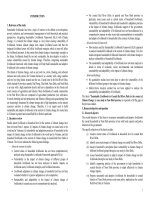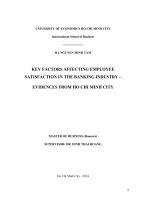Factors affecting consumer behavior in the market of home furniture hanoi case
Bạn đang xem bản rút gọn của tài liệu. Xem và tải ngay bản đầy đủ của tài liệu tại đây (1.09 MB, 70 trang )
VIETNAM NATIONAL UNIVERSITY, HANOI
VIETNAM JAPAN UNIVERSITY
TRAN QUANG HOAN
FACTORS AFFECTING CONSUMER
BEHAVIOR IN THE MARKET OF HOME
FURNITURE – HANOI CASE
MASTER'S THESIS
VIETNAM NATIONAL UNIVERSITY, HANOI
VIETNAM JAPAN UNIVERSITY
TRAN QUANG HOAN
FACTORS AFFECTING CONSUMER
BEHAVIOR IN THE MARKET OF HOME
FURNITURE – HANOI CASE
MAJOR: BUSINESS ADMINISTRATION
CODE: 8340101.01
RESEARCH SUPERVISORS:
Prof. Dr. Hiroshi Morita
Assoc. Prof. Dr. Pham Thi Lien
Hanoi, 2021
LETTER OF DECLARATION
I hereby declare that the Master thesis “Factors effecting consumer behavior
in the market of home furniture – Hanoi case” is the results of my own research and has
never been published in any work of others. During the implementation process of this
project, I have seriously taken research ethics; all findings of this projects are results of my
own research and surveys; all references in this project are clearly cited according to
regulations.
I take full responsibility for the fidelity of the number and data and other contents of
my graduation project.
Hanoi, 31st May 2021
Hoan
Tran Quang Hoan
ACKNOWLEDGEMENT
First of all, I would like to express the sincerest gratitude to my supervisor, Prof. Dr.
Morita Hiroshi and Prof. Dr. Pham Thi Lien who are enthusiastic, dedicated to guide and
give me the advice how to make my research done properly throughout the last two months.
I am very thankful to have them as my instructor.
I also would like to express my gratitude to all the lecturers and professors of
Vietnam Japan University – Faculty of Business Administration, who gave me the very
useful and practical knowledge about international business and other fields during five
years I studied here. That helped me a lot when I conducted this research.
Besides, I also would like to say thank you to all the participants who helped me
answering the questionnaires so that I can get data to do the research. I really appreciated
those who spent time on helping me completing the survey.
Finally, I wish all the best will come to my supervisor and all the lecturers and
professors of Vietnam Japan University – Faculty of Business Administration. Wish
everyone will have more happiness in life and more success in career.
TABLE OF CONTENT
LIST OF TABLES ............................................................................................................... i
LIST OF CHARTS AND FIGURES .................................................................................. ii
LIST OF ABBREVIATIONS ............................................................................................ iii
Chapter 1. INTRODUCTION ............................................................................................. 1
1.
Problem discussion ................................................................................................ 1
2.
Research objective ................................................................................................. 2
3.
Research scope ....................................................................................................... 2
4.
Thesis outline ......................................................................................................... 2
Chapter 2. LITERATURE REVIEW .................................................................................. 4
2.1. Overview of consumer behavior .............................................................................. 4
2.2. Factors affecting consumer behavior........................................................................ 5
2.3. Previous research about purchasing behavior of consumers. ................................... 6
2.4. Literature gap .......................................................................................................... 11
2.5. Hypotheses development ........................................................................................ 11
2.6. Research model .................................................................................................... 15
CHAPTER 3. RESEARCH METHODOLOGY ............................................................... 17
3.1. Research process .................................................................................................. 17
3.2. Data collection ..................................................................................................... 18
3.2.1.
Data collection method: survey method .................................................... 18
3.2.2.
Sample size ................................................................................................ 18
3.2.3.
Sampling method ....................................................................................... 18
3.3. Questionnaire design ............................................................................................ 19
3.4. Analyzing data plan ............................................................................................. 22
3.4.1.
Reliability testing of scales ........................................................................ 24
3.4.2.
Exploratory factor analysis (EFA) ............................................................. 25
3.4.3.
Multivariate regression analysis ................................................................ 26
CHAPTER 4. DATA ANALYSIS & HYPOTHESIS TESTING ..................................... 28
4.1. Descriptive data ................................................................................................... 28
4.2. Analysis and result ................................................................................................. 30
4.2.1.
The reliability of the scale ......................................................................... 30
4.2.2.
Exploratory factor analysis (EFA) ............................................................. 33
4.3. Hypotheses testing ............................................................................................... 36
4.3.1.
Correlation and regression analysis ........................................................... 36
4.3.2.
Hypotheses testing ..................................................................................... 39
4.4. Findings and discussion ....................................................................................... 42
CHAPTER 5. RECOMMENDATION AND CONCLUSION ......................................... 44
5.1. Recommendation ................................................................................................. 44
5.2. Research contributions ......................................................................................... 45
5.2.1.
Theoretical Contributions .......................................................................... 45
5.2.2.
Practical Contributions .............................................................................. 46
5.3. Limitations and future research direction ............................................................ 46
Reference ........................................................................................................................... 48
Appendix 1: Survey (English version) .............................................................................. 51
Appendix 2: Survey (Vietnamese version)........................................................................ 56
LIST OF TABLES
Table 2.1. Factors influence purchasing decision home furniture ...................................10
Table 3.1. Measuring items for questionnaire .................................................................20
Table 3.2. Encoded terms for data testing .......................................................................23
Table 4.1. Description of respondents’ profile ................................................................28
Table 4.2. Cronbach's Alpha analysis results table..........................................................30
Table 4.3. Table of results of EFA analysis of independent variables ............................33
Table 4.4. Results of Pearson correlation analysis ..........................................................36
Table 4.5. R Square, dependent variable Attitude ...........................................................37
Table 4.6. R Square, dependent variable Intention ..........................................................38
Table 4.7. Table of statistical parameters of each variable in the regression model .......38
Table 4.8. Summary results for the hypotheses ...............................................................41
LIST OF CHARTS AND FIGURES
Figure 2.1. Characteristics Influencing Consumer Behavior ..........................................5
Figure 2.2. Black box model ...........................................................................................7
Figure 2.3. TRA theory ....................................................................................................8
Figure 3.1. Research process proposed ...........................................................................17
LIST OF ABBREVIATIONS
ASS:
ATD:
EVBN:
INT:
P:
PD:
PQ:
SL:
SM:
After-sale service
Attitude
EU-Vietnam Business Network
Intention
Price
Product Design
Product Quality
Store Location
Social Media
CHAPTER 1. INTRODUCTION
1. Problem discussion
Along with the development of the country, for each family, the problem of
building a house is not simply the residence of family members, but also a place to
relax, rest, and show the personality of the owner of that house. Therefore, the design
of living space and interior decoration requires more aesthetics and diversity. With an
average GDP growth rate of 6% per year, accompanied by the development of the
construction and real estate sectors, an increase in household income will also increase
the consumption of home furniture.
According to a report on Vietnam furniture market made by EVBN, Vietnam
ranks first in Southeast Asia, 2nd in Asia and 4th in the world in furniture exports. Only
in 2015, in the European market, the total export turnover of furniture reached 7.2
billion USD and 1.7 billion USD for home decoration items. The development of the
furniture manufacturing industry in Vietnam is forecast to grow steadily at a rate of
9.4% per year. According to EVBN's analysis, the current Vietnamese furniture market
is mainly focused on export and left the home yard open. Most of the domestic market
is the playground for imported goods, originating mainly from China, Malaysia and
Thailand.
The furniture domestic market still has a lot of potentials for businesses. Home
furniture is a very potential market and there are many different segments for each
customer group with different income in society. Due to such a large and diverse
customer file, it is difficult to grasp the customer's wishes: which type to use, and how
to design is a matter of changing depending on individual perceptions. Research on
consumer behavior towards home furnishings will be needed to generalize customer
wishes. However, there are currently no studies in Vietnam that focus on analyzing
consumer behavior towards interior products. Therefore, I choose the topic: “Factors
affecting consumer behavior in the market of home furniture – Hanoi case” as the thesis.
1
Research question
What are the factors which affects consumers purchasing intention when buying
home furniture?
2. Research objective
The objective of the thesis is to benefit manufacturers and retailers of furniture
industry in Vietnam. The thesis aims to understand the furniture consumer behavior in
Vietnam by studying their purchase intention. This thesis will study any influences,
both positive and negative, that may impact customers’ purchase intention. Once
consumer behavior is realized, manufacturers and retailers can use the information to
adapt their company strategy to match the market needs.
3. Research scope
Research design: This research is based on the theoretical basis of consumer
behavior, and the number of related previous studies. Research is conducted in two
phases: qualitative research and quantitative research. From synthesizing secondary
data, I give the factors affecting buying behavior of consumers, then conducting
quantitative research through consumer opinion survey in Hanoi. Since then, on basis
of analysis of primary data, the author proposes the number of solutions to help
businesses develop the market for home furniture in Hanoi.
Object and scope of the study
-
Object: Home furniture consumers in Hanoi
-
Scope of the study: Research is carried out to find out the purchase
intention of home furniture in the period of 2017 - 2020 and vision to 2025.
4. Thesis outline
This thesis consists of six chapters including introduction, literature review,
hypotheses and framework development, research methodology, Hypotheses testing
results, and conclusion and recommendation. After the main body of the thesis, there
2
will be references and two sections of appendices. Two appendices are questionnaire in
English and in Vietnamese.
3
CHAPTER 2. LITERATURE REVIEW
2.1. Overview of consumer behavior
According to M. Khan (2007), consumer behavior is the study of what to buy,
how to buy, where to buy, and when to buy in what quantity. Apart from the decision
of to buy and not to buy, there is also a decision regarding which source to buy.
Consumer behavior is also the study of factors that affect the behavior both internal and
external such as, self-concept, social and cultural background, age, family, attitudes,
personality, and social class.
Consumer’s behavior can also be understood as the whole action that consumers
expose in the process of investigating, purchasing, using and evaluating goods and
services in order to satisfy their needs. Consumer behavior can be considered as the way
that consumers will make decisions about the use of their assets (money, time, effort,
etc.) in relation to their purchases and use. use goods and services to satisfy individual
needs (Kotler, 2007).
According to Kotler (2012), marketer studies consumer behavior with the aim of
identifying their needs, preferences, habits, namely what consumers want to buy, why
they buy that product or service, and choose that brand, how they buy, where to buy,
when to buy and how much to buy to build a marketing strategy to drive consumers to
shop.
In short, consumer behavior is the thoughts, feelings and actions that take place
in the process through the consumer's decision to purchase goods or services under the
interaction between stimuli of their external environment and their internal
psychological processes.
According to Ajzen (1991), the intentions of the consumer are an indicator of the
extent to which people are willing to carry out a specific behavior, which in this research
would be translated as purchase decision. Purchase intention is considered to be the
main predictor of actual purchase behavior. (Montaño and Kasprzyk, 2015). This point
is also asserted by Armitage and Conner (2001), this research proposes to purchase
4
intentions as the key variable to be investigated. The construct takes place at the prepurchase stage and captures the motivational aspects that affect customer behavior. To
predict consumer behavior, it is necessary to know the attitudes, assessments, and
internal factors that ultimately generate the purchase intent (Fishbein and Ajzen, 1977).
Thus, in this study the author assumes that purchase intention will lead to purchase
decision, so the author focuses on finding the factors affecting the intention to purchase
home furniture.
2.2. Factors affecting consumer behavior.
Consumer behavior is influenced by a variety of factors in the external
environment and consumer characteristics. Consumer characteristics affect how
consumers perceive and react to the stimuli. Consumers are shaped to some extent by
the environment in which consumers live and consumers influence environments
through consumer behaviors in turn (Blackwell et al., 2006). Consumer purchasing
decisions are strongly swayed by culture, social, personal, and psychological
characteristics (Kotler & Armstrong, 2004), as can be seen in Figure 2.2.
Figure 2.1: Characteristics Influencing Consumer Behavior
(Source: Kotler & Armstrong, 2004)
5
Accolading to Kotler & Armstrong (2004):
Cultural factors that exert intensely influence on consumer behavior consist of
culture, subculture, and social class factor.
Social factors such as reference groups, family, and social roles and status also
impact consumer behavior.
A purchaser’s decisions are also influenced by personal characteristics such as
the purchaser’s age and life-cycle stage, occupation, economic situation, lifestyle, and
personality.
An individual’s purchasing choices are further influenced by four major
psychological factors. Four factors consist of motivation, perception, learning, and
beliefs and attitudes.
Economic scientists were the first among social scientists to study consumers
and their behavior and provided the details about the solutions to the consumer and
consumption problems. Economists, as we are aware, took man as a social and rational
animal. The basic economic determinants among others are: personal income, family
income, income expectations, liquid assets, government policy.
2.3. Previous research about purchasing behavior of consumers.
In this study, the author mentioned the consumer behavior model of Kotler
(2007) and the theory of reasoned action (TRA) and several researches related to
consumer behavior in the furniture market.
According to Kotler's model, consumers behavior consists of 4 Marketing mix
mixes that can affect the black box of consumer consciousness to stimulate them to
make decisions. product selection, in which price is a key factor in a consumer-sensitive
market. Choosing the right price strategies is the condition for getting a competitive
advantage.
6
Figure 2.2: Black box model
(Source: Kotler & Armstrong, 2004)
As illustrated in the figure above, the external stimuli that consumers respond to
include the marketing mix and other environmental factors in the market. The marketing
mix (the four Ps) represents a set of stimuli that are planned and created by the company.
The environmental stimuli are supplied by the economic, political, and cultural
circumstances of a society. Together these factors represent external circumstances that
help shape consumer choices.
The internal factors affecting consumer decisions are described as the “black
box.” This “box” contains a variety of factors that exist inside the person’s mind. These
include characteristics of the consumer, such as their beliefs, values, motivation,
lifestyle, and so forth. The decision-making process is also part of the black box, as
consumers come to recognize they have a problem they need to solve and consider how
a purchasing decision may solve the problem. As a consumer responds to external
stimuli, their “black box” process choices based on internal factors and determine the
consumer’s response–whether to purchase or not to purchase.
7
Like the economic man model, this model also assumes that regardless of what
happens inside the black box (the consumer’s mind), the consumer’ response is a result
of a conscious, rational decision process. Many marketers are skeptical of this
assumption and think that consumers are often tempted to make irrational or emotional
buying decisions. In fact, marketers understand that consumers’ irrationality and
emotion are often what make them susceptible to marketing stimuli in the first place.
For this reason, consumer purchasing behavior is considered by many to be a
mystery or “black box.” When people themselves do not fully understand what drives
their choices, the exchange process can be unpredictable and difficult for marketers to
understand.
The TRA is a very well known theory given by Fishbein & Ajzen (1975). It has
its roots in the field of social psychology. Figure 2.3 gives an overview of what the
theory entails.
Figure 2.3: TRA theory
(Source: Fishbein & Ajzen, 1975)
The TRA discusses the relationship between beliefs, norms, attitudes, intentions,
and behaviors of individuals. It suggested that a person’s behavioral intentions
determine a person’s behavior. The person’s subjective norms and attitudes towards the
behavior determine this intention. This model suggests that by adjusting the structure
of an individual’s beliefs, external stimuli have an impact on attitudes. This theory also
suggests that other factors called ‘external variables’ have an indirect effect on behavior
by influencing the subjective norm.
8
The TRA model focuses on the construction of a system of observation of two
groups of variables, which are:
+ attitudes defined as a positive or negative feeling in relation to the achievement
of an objective;
+subjective norms, which are the very representations of the individuals’
perception in relation to the ability of reaching those goals with the product.
The author emphasizes the importance of purchase intention to actual purchase
decision.
In addition, several factors considered when furniture purchase is taken into
consideration. For the purpose of this research, a few factors that considered most
important for furniture purchase taken into consideration and their effects have seen.
Research “Factors Affecting Furniture Purchase in Pakistan”, M. F. Qureshi &
A. Kamaran et al. give 5 factors to consider including: (1) Price, (2) Customer service,
(3) Product Quality, (4) Brand Loyalty, (5) Customer reviews. The result show that how
much of an effect price on the purchase of furniture, how important the effect of product
quality in on customer attitude. The study has shown how brand loyalty is a very
important factor in shaping customer attitude. The hypothesis on the relationship
between customer reviews and customer attitude was substantiated and failed to reject.
(M. F. Qureshi & A. Kamaran et al., 2020).
Research “The influence of marketing mix factors in purchasing decision for
wooden furniture case of furniture Bogor”, Parmana et al. analyzed of the factors that
influence the decision to purchase furniture products at Furnimart Bogor, it can be
concluded as follows: the behavior of purchasing furniture products that are based on
consumer perceptions is influenced by product design, product completeness, product
quality, discount rates up to 70%, easy payment method, easy to reach store location,
fast delivery, store convenience, attractive sales promotion, good SA service, as well as
social media promotion. Factors that are considered to have the most significant
9
influence in purchasing decision from SEM analysis result are price and promotion.
(Parmana et al., 2019).
Research “Consumer behavior in purchasing home furnishing products in
Thailand”, Thanyamon consider 7 factors that have influences on furniture purchasing
decision process including: (1) Product quality, (2) Product design, (3) Brand loyalty,
(4) After-sales services, (5) Price, (6) Store location, (7) Speed delivery. The result
shown that the most important factors influencing furniture choice were Product quality,
product design and price of the product. (Thanyamon Sakpichaisakul, 2012).
Research “Understanding Furniture Decision Making Process and Design
Preference using Web-Based VR Technology”, So-Yeon Yoon & Ji Young Cho (2009)
emphasized the importance of product design in the purchasing decision.
Research “Consumer Behavior Model on the Furniture Market” consider 5
factors that have influences on furniture purchasing decision process including: (1)
Product quality, (2) Price, (3) Customer service, (4) Social media, (5) Customer review.
The result shown that Product quality ranks as the most important evaluative criterion
when furniture is being considered for purchase.
Table 2.1 shows some of the research works on this topic and the factors
investigated in those prior studies.
Table 2.1. Factors influence purchasing intention home furniture
No
1
Factor
Attitude
2
Product quality
3
Product design
4
Price
References
1. M. F. Qureshi & A. Kamaran et al. (2020)
2. Parmana et al. (2019)
3. Thanyamon (2012)
4. M. F. Qureshi & A. Kamaran et al. (2020)
5. Parmana et al. (2019)
6. Ying Li et al. (2016)
1. Parmana et al. (2019)
2. Thanyamon (2012)
3. So-Yeon Yoon & Yi Young Cho (2009)
4. Éva & Judit (2010)
1. M. F. Qureshi & A. Kamaran et al. (2020)
10
5
Store location
6
Social media
7
After-sales service
2.
3.
4.
5.
1.
2.
3.
1.
2.
3.
1.
2.
3.
Parmana et al. (2019)
Ying Li et al. (2016)
Thanyamon (2012)
Éva & Judit (2010)
Parmana et al. (2019)
Thanyamon (2012)
Nicole Ponder (2013)
Parmana et al. (2019)
Éva & Judit (2010)
Nicole Ponder (2013)
Parmana et al. (2019)
Ying Li et al. (2016)
Thanyamon (2012)
2.4. Literature gap
According to Mr. Phan Dang Chuong - Deputy General Director of Ernst &
Young Vietnam Limited, in the past 5 years, there have been about 400,000 - 500,000
apartments of townhouses, luxury apartments born in Vietnam. On average, each
apartment uses at least 1-2 hundred million VND for the interior, so there are over
100,000 billion VND for this need. Therefore, the need to learn about factors affecting
consumers' buying behavior is essential. Moreover, these factors can differ from person
to person, culture-to-culture, country to country, place-to-place, etc.. This research will
conduct to mainly focus on Vietnam.
This study also aims to examine how the impact of factors changes when
furniture consumption trends and furniture demand are changing.
2.5. Hypotheses development
2.5.1. Relationship between customer attitude and purchase intention
There are different factors that affect consumers’ purchase intentions. These
characteristics are the consumers’ personal preferences, social standing, monetary
standings, and some other factors too (Mirabi V, Akbariyeh H, Tahmasebifard, 2015).
Purchase intention may be influenced under the effect of perceived quality, value, and
price. Moreover, internal, and external motivations also affect the buying intention of
consumers. Researchers have identified six stages before the decision-making stage of
11
consumers, which are: knowledge, awareness, interest, preference, persuasion, and
purchase (Kawa LW, Rahmadiani SF, Kumar S, 2013). Purchase intention is a widely
studied concept in marketing literature. Studies have been coordinated in different zones
of the world with the desire for understanding what truly impacts the purchase intention
of consumers (Kar P, Meena HR, Patnaik NM, 2018). There are some elements of a
brand, which have a solid impact on the purchase intention of a buyer i.e., product
quality, product involvement, brand image, brand loyalty, product knowledge and
product attributes (Abbasi E, Rostami S et al., 2015).
According to Allport (1935), attitude is an important determinant of the
predisposition of an individual and has a positive relationship with behavior. It is
defined as the level to which an individual makes a positive or negative assessment of
behavior (Fishbein and Ajzen, 1977). In this research, attitude is understood as the
assessment of the consumer about purchasing home furniture, following the work of
Andrews and Bianchi (2013).
According to TRA, intentions are the result of the attitude toward certain
behavior: the greater the positive attitude toward a behavior, the greater the intention of
carrying out the behavior (Amaro and Duarte, 2015). It is then expected that, if the
assessment of the consumer toward buying home furniture is positive, the consumer
intention to buy home furniture will increase. Thus, the first research hypothesis is
proposed:
H1: Attitude has a significant positive effect on purchase intention.
2.5.2. Relationship between product quality and customer attitude
Product quality defined as the collection of characteristics and features that play
a part in its ability to meet the specified requirements. Brands play their part in perceived
quality when they want the consumers to perceive the quality to be competent in
comparison with the competitors. The better the product quality, the stronger an effect
it has on customer attitude (Eva Bedn´arik, Kov ´ ats JP, 2010). In a study, it was found
that there is a strong connection between the two. The prerequisite of quality commands
12
that producers deliver items that satisfy the shopper’s desire for sturdiness (Alfred O,
2013). Hence the second hypothesis is:
H2: Product Quality has a significant positive effect on customer attitude.
2.5.3. Relationship between design product and customer attitude
Psychologist Carl Jung (1967) noted that self-archetype can be displayed through
self-expression in built form. Home, as a representative of built form, is considered an
expression of self-image (Cooper, 1976). So-Yeon Yoon & Ji Young Cho (2009)
emphasized the importance of product design in the purchasing decision. Thus, the third
hypothesis is:
H3: Product Design has a significant positive effect on customer attitude.
2.5.4. Relationship between price and customer attitude
Price considered among the topmost concerned factors when it comes to
purchasing any goods and services. Different types of pricing strategies are therefore
adhered to cater to the different types of customers in the market (Hansen H, 2013).
There is a relationship between price and the buying behavior of the customers; it is not
necessary that high priced items are always considered as not-to-buy items but, there
may be a chance that due to its high pricing, consumer perceived value for the product
increases because the customer might link price with high-quality product (Alhadda A,
2014). Price acts as an imperative factor in consumer purchases in mostly all types of
products and services, unless the nature of the product is otherwise, like lifesaving drugs
(Laroche M, Habibi MR, Ricard MO, Sankaranarayanan R, 2012). Thus the fouth
hypothesis is:
H4: Price has a significant positive effect on customer attitude.
2.5.5. Relationship between store location and customer attitude
Location is the factor which is of utmost importance in retailing and plays a very
crucial role for consumer store choice. A favorable location shall be a place that
consumer perceives is quite good and reasonable for shopping with ample availability
13
of public transports, well wide parking area and consumer friendly environment.
According to Tinnie(2010) store characteristics include store layout, presence of
salespeople, store atmospherics and store type. Precisely, store environment, design of
the store, presentation and location of merchandise are considered to be important part
of store characteristics. Another reason for retailers to design their stores and to use
different marketing tools is to give stimulus to consumers to purchase the goods
impulsively. According to Bellenger (1978) the consumers shopping behaviour is
divided into two types including planned and impulse purchase based on where buying
decision is made. Planned purchase decision is made before visiting the store, whereas
impulse purchase decisions are made inside the store due to the in-store stimuli (cited
in Raposo, 2013). Consumers’ stimuli to buy things impulsively are triggered through
store layout, signage (category, promotional, point of sale), feature areas (window
display, promotional area, and entrance), visual merchandising and store atmosphere
(lighting, color, music, scent). Therefore, it is important for retailers to understand the
impact of in-store characteristics on consumer impulse buying behaviour since impulse
purchases constitute large percentage of supermarket sales.
Thus, the fifth hypothesis is:
H5: Store location has a significant positive effect on customer attitude.
2.5.6. Relationship between social media and customer attitude
Social media is all about facilitating people to express and share ideas, thoughts,
and opinions with others. It is also about enabling people to connect with others, like
they were doing for the last thousands of years. In parallel with the above advances in
the area of social media, there are also major changes at the consumer level that impact
consumer behaviour. Changes in values and lifestyles, shorter leisure time, and search
for value for money have led to a new breed of tourism consumers: More informed,
more independent, and more individualistic (Poon, 1993). At the same time, travelrelated consumer behaviour has become increasingly contradictory (Marabella 2004).
For example, consumers demonstrate contradicting holiday lifestyles within relatively
14
short periods of time: they are willing to pay for luxury travel experiences but at the
same time they search the web for the best hotel rate (Gretzel et al. 2006)
Hence the sixth hypothesis is:
H6: Social media has a significant positive effect on customer attitude.
2.5.7. Relationship between after-sales service and customer attitude
After-sales service involves making sure that the customer’s needs are fully met
according to what he desires. Customer service involves tending to the necessities and
needs of any customer. The better the customer service, the better will be the customer
attitude towards their purchase (Jahanshahi AA, Gashti MAH, Mirdamadi SA, Nawaser
K, Khaksar SMS, 2011). Some qualities of good customer service include Promptness
i.e., ensuring that things are always on time and no customer has to be kept waiting (Hsu
CL, Chang KC, Chen MC, 2012). Other is politeness i.e., being very sociable and sweet
in conduct as a way of pleasing the customer so that his experience is enhanced
(Jahanshahi AA, Gashti MAH, Mirdamadi SA, Nawaser K, Khaksar SMS, 2011).
Professionalism i.e., customers should be dealt with professionally, with to-the-point
conversations mostly pertaining to the point in concern (Bashir F, Soroya SH et al,
2015). Personalization involves referring to customers by taking their names so that
they feel honored and valued (Jasmand C, Blazevic V, de Ruyter K, 2012). The kind of
administration that customer experience will rely upon the item or administration that a
business gives, what the customers’ needs are, and whether the administration is issue
situated or centered toward upgrading the purchaser’s involvement (Agnihotri R,
Dingus R et al., 2015).
Hence the seventh hypothesis is:
H7: After-sales service has a significant positive effect on customer attitude.
2.6.
Research model
15
Product Quality
H2
Product design
Price
Store location
H3
H4
Attitude
H5
H6
Social media
H7
After-sale service
16
H1
Purchase
Intention









